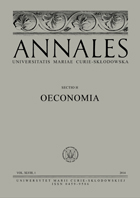Digital Disruption in Art: A Comprehensive Analysis of AI and NFT Market Dynamics
Digital Disruption in Art: A Comprehensive Analysis of AI and NFT Market Dynamics
Author(s): Michał WłodarczykSubject(s): Visual Arts, ICT Information and Communications Technologies, Sociology of Art
Published by: Wydawnictwo Naukowe Uniwersytetu Marii Curie-Sklodowskiej
Keywords: artificial intelligence; NFT; AI-generated art; digital art; cryptocurrency;
Summary/Abstract: Theoretical background: The dynamic development of generative artificial intelligence such as ChatGPT has transformed the perception of creative work. In the graphic realm, AI systems like Midjourney, DALL-E, or Adobe Firefly allow the creation of high-quality graphics without the need for artistic skills or hiring a talented designer. Concurrently, the emergence of cryptocurrencies and the associated non-fungible tokens (NFTs) has resulted in radical changes in the creative sector, especially in the art market.Purpose of the article: The aim of this article is to examine the development pace and impact of AI-gen- erated art and NFTs on the global art market, focusing on market trends, dependency on energy prices, segmentation, and how these changes influence artwork pricing and artists’ livelihoods.Research methods: The author has assessed the popularity and development of the NFT market, as well as the main reasons for its collapse in 2022. The author identified possible scenarios for the development of the art market, pointed out the primary potential threats, and highlighted the key determinants of future digital asset valuation.Main findings: Despite initial euphoria, buyers depreciate digital goods, especially those generated by artificial intelligence. They are considered inherently inferior and less valuable. Overproduction of works combined with the availability of AI solutions means that the traditional supply and demand mechanism lowers the price of assets and thereby forces more and more graphic designers, photographers, and painters to abandon their professions. Competition from artificial intelligence is subject to the same supply and demand mechanisms, which reduces the cost of access to quality graphics for entrepreneurs and individuals. Simultaneously, as the market becomes saturated with synthetic goods, there will be a delineation at the segment level, similar to what has happened with artisanal beers, hand-assembled cars, and furniture, or handmade ceramics. An unwritten, “made by humans” certificate will result in a 300–500% higher price for similar goods made by humans compared to works of artificial intelligence. This situation will resemble the division of the clothing or furniture market into mass-produced goods and designer items. Amid all this, the increasingly prominent role of NFTs will be evident, which will also appreciate in value, but due to the ecological taxation resulting from energy consumption that is 100,000 times higher than that of a regular bank payment.
Journal: Annales Universitatis Mariae Curie-Skłodowska, Sectio H Oeconomia
- Issue Year: LVIII/2024
- Issue No: 2
- Page Range: 171-193
- Page Count: 23
- Language: English

